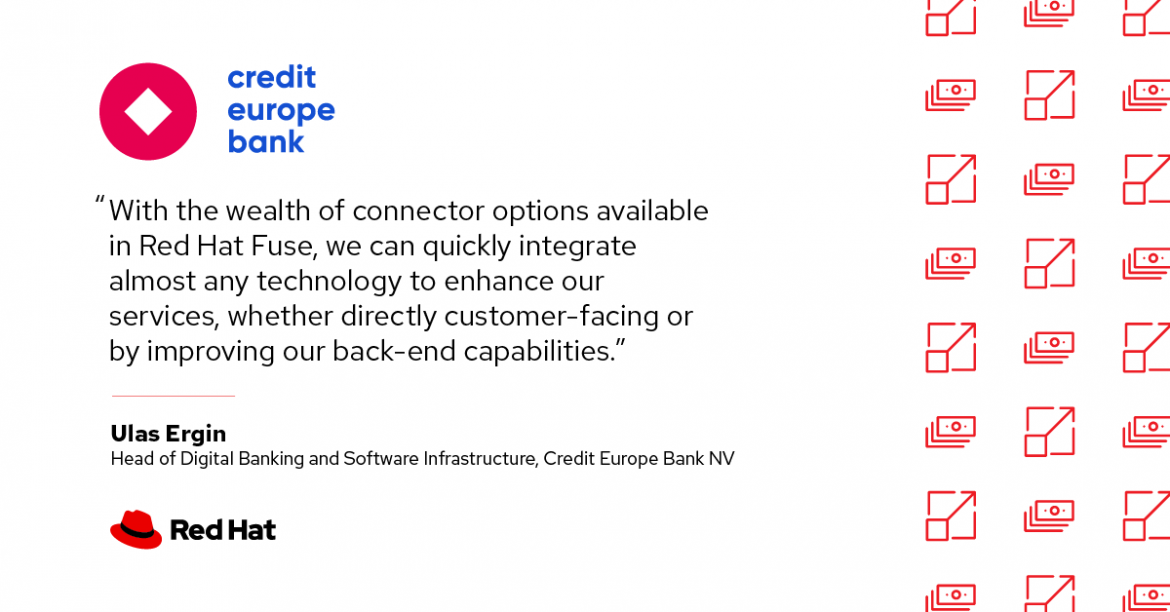Blog Red Hat
From financial institutions to universities, organizations around the world have counted on Red Hat OpenShift to face challenges and stay competitive with considerable flexibility. In this month’s customer success highlights, learn how Red Hat’s enterprise Kubernetes platform—along with our other solutions and services—has helped Credit Europe Bank, Santander Colombia, and Universidad Mayor adapt to demands in a rapidly changing world.
And Red Hat’s container technology is not just helping these organizations tackle today’s priorities, it’s also helping lay the groundwork for future scalability. Even if their deployments have taken place on-premise, some of these customers are setting their eyes on a hybrid cloud future.
Credit Europe Bank embraces a cloud-based approach for speed and flexibility
Established in 1994, Credit Europe Bank NV (CEB) provides financial services to more than 900,000 corporate and retail customers across six different countries. CEB was getting started with cloud-native technologies and sought a solution that would provide not only the required technology capabilities, but also comprehensive security features, reliability, and support.
“Integrations took a lot of time and effort. We wanted to move to a cloud- and microservices-based approach that would give us the speed and flexibility to be more responsive to the market,” said Ulas Ergin, Head of Digital Banking and Software Infrastructure, CEB.
To support its digital transformation efforts, CEB decided to adopt Red Hat OpenShift and Red Hat Integration. CEB initially implemented Red Hat OpenShift 4 in an on-premise virtual environment, including clusters for development, testing, pre-production, and disaster recovery.
Red Hat Fuse was among the several Red Hat Integration technologies the company implemented. Red Hat Fuse supports communication between CEB’s new microservices, legacy Java EE banking system, and third-party partners. Additionally, Red Hat AMQ helps CEB support real-time, event-based communications between these microservices, as well as asynchronous logging.
The bank has launched a major new release every two months since go-live for its digital banking platform. These new releases have included video onboarding with live-chat, renewed online banking with new mobile applications and digital onboarding with ID scan. In total, CEB completed four projects in 2021—a significant achievement in productivity.
CEB has worked closely with Red Hat Support during and after implementation of its new technology to optimize performance and troubleshoot any issues before they affect customer-facing services. Head to the full case study to read more about how CEB has counted on Red Hat products and services to better meet customer demands.

Santander Colombia improves service integration with hybrid cloud architecture
Banco Santander de Negocios Colombia, S.A. (BSNC) is the Colombian division of the global Santander Group. When BSNC entered the retail banking market, its transaction processing approach and the IT architecture it inherited from its parent group lacked the flexibility and scale to build new services to meet customer demand. Additionally, its architecture needed an abstraction layer to connect new sales channels with the bank’s existing core system for credits and payments.
Working with ITAC, a Red Hat partner, BSNC decided to implement a hybrid cloud architecture based on Red Hat integration and container platform technology. BSNC deployed its new Red Hat technology and completed its first project in just two months.
“We chose to run Red Hat Integration on Red Hat OpenShift because this solution allowed us to convert core banking processes into microservices,” said Carlos Camacho, CIO at BSNC. “Red Hat also offered us a cost-effective, security-focused path to make improvements now while abstracting our core system to potentially update later. The only implementation cost has been the software subscriptions.”
With improved integration of sales with the bank’s core credits and payments system through an abstraction layer, BSNC can expand to develop new channels for its financing products. BSNC has also used the abstraction layer of its API- and microservices-based architecture to expand its data processing to accommodate large volumes of information.

Universidad Mayor adapts to COVID-19 with container technology and DevOps approaches
Universidad Mayor is a Chilean higher education institution with 30 years’ history, 11 campuses, and approximately 25,000 students. The university worked with Red Hat to develop a strategic approach to modernizing not only its IT infrastructure but also its work processes in response to the COVID-19 pandemic.
The university’s IT teams sought to continue learning about and adopting new technologies, including Kubernetes orchestration for container-based applications. Universidad Mayor worked with Red Hat Consulting through Red Hat Open Innovation Labs, an immersive team engagement that helps attendees adopt the skills, tools, and processes to deliver enhanced services and solutions faster.
During its initial four-week virtual residency, Universidad Mayor’s teams worked closely with Red Hat’s expert consultants and engineers to learn best practices for collaboration and the optimal use of enterprise open source technology. They also mapped technology and cultural changes to align with desired business outcomes.
As part of this work, the university adopted Red Hat OpenShift. Universidad Mayor also participated in two courses with Red Hat Training, including the DO700 Container Adoption Bootcamp course on how to use OpenShift for operations, administrations, deployments troubleshooting and cluster health. Check out our YouTube video to hear what some of the university’s leaders have to share about their Open Innovation Labs experience.
But wait, there's more!
We regularly publish case studies to help illustrate how our products and services can help organizations solve their problems and improve their environments. Visit our Red Hat Success Stories page and find out how Red Hat technologies can help you find success.
About the author
Red Hat is the world’s leading provider of enterprise open source software solutions, using a community-powered approach to deliver reliable and high-performing Linux, hybrid cloud, container, and Kubernetes technologies.

